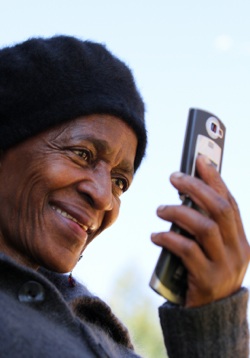A magazine where the digital world meets the real world.
On the web
- Home
- Browse by date
- Browse by topic
- Enter the maze
- Follow our blog
- Follow us on Twitter
- Resources for teachers
- Subscribe
In print
What is cs4fn?
- About us
- Contact us
- Partners
- Privacy and cookies
- Copyright and contributions
- Links to other fun sites
- Complete our questionnaire, give us feedback
Search:
Gadgets that get better as they get older

No matter how tech-savvy you are, at some point or other you'll be baffled by a gadget. Everyone spends some time trapped in confusing menus. Everyone has to wade through jargon they don't understand, or search for a cable they didn't know they needed. As people get older, though, they often find themselves having more trouble using technology. After all, most technology isn't designed with them in mind – usually it's been designed for the young males who are stereotypically more interested in gadgets. That sitation will have to change soon, though, as our population is getting older. So a group of computer scientists at Dundee University is studying the hurdles that older people face when they use technology. They want to be able to help designers consider how to improve the experience of older people with their gadgets.
What does it mean to say that the population is getting older? Well, back in the 1960s in Scotland, 15% of the population was over 60. By 2025, that proportion will have doubled – 30% will be over 60. People are living longer, and they tend to be having fewer children, so older people are making up more of the population. When a third of potential users are over 60, it makes good business sense to make sure they find technology easy to use. Plus if technology can help older people live longer independently, it will cost less to care for them.
Tough to control
Older people can face lots of different difficulties when using technology, and many of those difficulties are related to the design of the controls. Many older people have less manual dexterity and don't see as well as they used to, so punching small buttons can be tough. Learning new controls can be difficult, especially when they're overly complicated. Bad labelling or confusing colour-coding can make the problem of complicated controls worse. Sometimes just the fact that the controls are different from what they're used to can be a problem. The reasons for those differences don't always seem to make much sense – why should ITV be channel 103 on digital when it's always been channel 3?
It's not always the interface that's confusing. Sometimes it's the jargon surrounding the technology that's difficult to understand. That's not helped if the manual's confusing either. Or if your new tech is difficut to install – like if you have to sort through a jungle of cables to do it. Sometimes older people rely on a younger person to help them set things up, but they can't always be around, and anyway the point of good technology is for as many people to be able to use it as possible.
Gran designs
So how can designers make it easier for older people to use technology? That's one of the purposes of the group in Dundee. They're meeting with older people and finding out what makes it difficult for them to use technology. As part of this research, and to raise designers' awareness of the challenges technology provides for older people, they have produced a number of videos including one called Relative Confusion, about a group of older people using various electronics. The researchers in Dundee are also making sure designers are talking to their older users. Involving older users in the design process will help, rather than assuming that each user is that sterotypical young male. One of the added benefits of considering the needs of older users is that it tends to make technology easier to use for everyone else too. Surely no one actually likes tiny, identical buttons or crazy maze-like menus. The more designers think about older users, the sooner we'll get rid of those snazzy but maddening interfaces.


